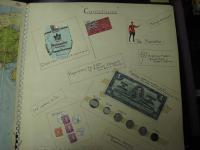Among its other archival resources, the Millbrook Society in the Hatboro suburb of Philadelphia boasts a small but singularly compelling accumulation of scrapbooks. The Mary E. Taffe scrapbooks collection consists of 6 volumes lovingly and meticulously constructed by Taffe, librarian for the Philadelphia Inquirer and Daily News, about vacations she took from 1948-1960. The scrapbooks are a treasure trove of ephemera from the places she visited: What did Canadian stamps look like in 1951? What cigarettes were popular? Look in Taffe's scrapbook! But more than that, the Taffe scrapbooks offer a rich and colorful picture of her life. She traveled as a single woman, or together with one female friend, on all of the trips described in this collection. What did that feel like, in the late 1940s-1950s, on the eve of the women's liberation movement? The scrapbooks show that Mary's mother was concerned about her 20-something daughter's safety, but Mary was well-prepared and remained confident. How were the women received on their journeys? The scrapbooks offer a richly-illustrated and well-annotated glimpse into the personal experiences of Mary E. Taffe and her friends.
 Lest I give the impression that scrapbooks only speak to women's history, I should also highlight two volumes at the Millbrook Society created by soldiers during World War II: Norman C. Brauer, Jr. and Thomas Kingsley. (To be fair, it would probably be more accurate to say "photograph albums" rather than "scrapbooks." However, both books include at least a few newspaper clippings in addition to numerous photographs, so you can judge for yourself.) Scrapbooking was actually a very popular pastime among servicemen during World War II, to the point where "a peculiar subgenre of memory books" emerged--prefabricated scrapbooks like G-I've Been Around and Victory Scrapbook that were marketed particularly toward servicemen (Helfand, Scrapbooks, p. 130-133).
Lest I give the impression that scrapbooks only speak to women's history, I should also highlight two volumes at the Millbrook Society created by soldiers during World War II: Norman C. Brauer, Jr. and Thomas Kingsley. (To be fair, it would probably be more accurate to say "photograph albums" rather than "scrapbooks." However, both books include at least a few newspaper clippings in addition to numerous photographs, so you can judge for yourself.) Scrapbooking was actually a very popular pastime among servicemen during World War II, to the point where "a peculiar subgenre of memory books" emerged--prefabricated scrapbooks like G-I've Been Around and Victory Scrapbook that were marketed particularly toward servicemen (Helfand, Scrapbooks, p. 130-133).
 Both Brauer and Kingsley were stationed on Pearl Harbor during World War II: Kingsley before and during the attack, which he survived on board the USS Phoenix; and Brauer afterward, working to salvage ships including the USS Oklahoma. Brauer's scrapbook has a rather light-hearted tone, given the morbid circumstances that brought him to the Hawaiian paradise of Pearl Harbor. While acknowledging the tragedy of the sunken ships (and the crew aboard at the time), Brauer's scrapbook mostly basks in the success of the salvage operations, and documents some of the Hawaiian-themed festivities the servicemen enjoyed on base.
Both Brauer and Kingsley were stationed on Pearl Harbor during World War II: Kingsley before and during the attack, which he survived on board the USS Phoenix; and Brauer afterward, working to salvage ships including the USS Oklahoma. Brauer's scrapbook has a rather light-hearted tone, given the morbid circumstances that brought him to the Hawaiian paradise of Pearl Harbor. While acknowledging the tragedy of the sunken ships (and the crew aboard at the time), Brauer's scrapbook mostly basks in the success of the salvage operations, and documents some of the Hawaiian-themed festivities the servicemen enjoyed on base.
 Kingsley's scrapbook doesn't refer to his Pearl Harbor experiences at all, but centers around 1944. Kingsley was still aboard the USS Phoenix, which was now roaming around the Admiralty Islands. General Douglas MacArthur came to visit the ship during this time, and the scrapbook features some candid shots in the unmistakable style of an adoring fan.
Kingsley's scrapbook doesn't refer to his Pearl Harbor experiences at all, but centers around 1944. Kingsley was still aboard the USS Phoenix, which was now roaming around the Admiralty Islands. General Douglas MacArthur came to visit the ship during this time, and the scrapbook features some candid shots in the unmistakable style of an adoring fan.
Both the Kingsley and Brauer scrapbooks are contextualized by other resources at the Millbrook Society: an oral history with Kingsley; additional ephemera and photographs donated by Brauer. One could do a neat bit of research utilizing the scrapbooks at the Millbrook Society, and focusing on topics like Pearl Harbor, the life of a World War II soldier, or, returning to Ms. Taffe, gendered experiences of travel. Or, if you're like me, you might prefer to just browse through the scrapbooks and admire the artistry, design, and meticulous effort that went into these awesome little books.

